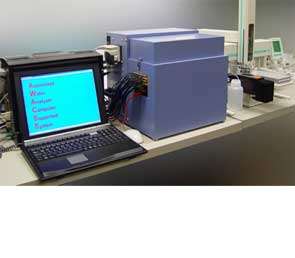AWACSS Hunts Hormones and Pesticides in Drinking Water

Siemens has developed a new portable analysis system for detecting harmful substances in bodies of water. As reported in the latest issue of the company’s research magazine "Pictures of the Future", the suitcase-sized device can test samples on its own and send the results to a central server. Previously, the samples had to be collected by hand and subsequently analyzed in the laboratory. Part of an EU project, the system was developed by researchers from Corporate Technology in Erlangen, in collaboration with the University of Tübingen, the Water Technology Center in Karlsruhe and other partners. A model was recently displayed at the IFAT Environment and Waste Disposal trade fair in Munich.
The drinking water drawn from lakes, rivers and ground water wells is subject to regular quality checks in Germany. In addition, the testing of surface water is prescribed by the European Union. It often takes one to two days until the results of testing are available. With the AWACSS system (Automated Water Analyzer Computer Supported System), though, no more than 15 minutes is needed to check for 32 different substances, ranging from antibiotics and pesticides to hormones. The device can detect even tiny concentrations of less than one microgram (one millionth of a gram) per liter. This level of precision is sufficient to determine if the water contains any pesticides. The results of the test are saved by a local computer, from which the data is transmitted via a wireless modem or a local area network (LAN) to a central server, where the data is then compared with existing parameters. If any discrepancies are discovered, the operator is notified by e-mail or text message.
The key component of AWACSS is a biochip that captures molecules of environmental toxins. The water sample is first mixed with antibodies that are marked with a fluorescent pigment. If the sample contains molecules of herbicides, for example, the antibodies attach themselves to the toxic particles. Once this process is completed, a pump propels the liquid across a small glass biochip coated with a layer of captor molecules. These molecules capture the antibodies, along with the toxins, while the remaining particles are rinsed from the chip. Laser light is used to cause the captured antibodies to glow, making them detectable by the device’s optical sensor. A single chip can be used for about 300 tests.

















